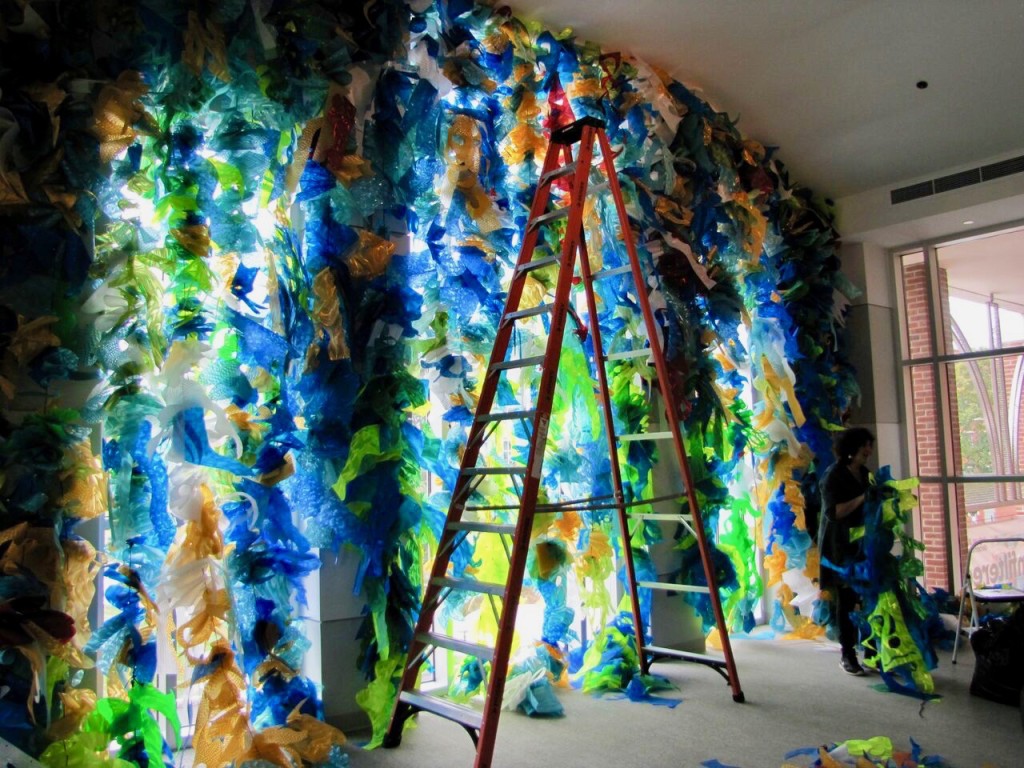THE WAVE: A COLLABORATIVE, PARTICIPATORY PUBLIC ART PROJECT ON WATER
The Wave is a national, interactive, public art project celebrating water and its vital function in our lives. It was created jointly by Susan Hoffman Fishman and Elena Kalman. Since September of 2011, The Wave has been installed in 24 museums, galleries, schools, universities, community centers, festival and parks including: The Peabody Essex Museum (Salem, MA); The National Aquarium (Baltimore, MD); The Rose Kennedy Greenway (Boston, MA); The Wadsworth Atheneum (Hartford, CT); Allegra LaViola Gallery (NYC); Governor's Island (NYC); The New Britain Museum of American Art (New Britain, CT), and others.
Origins of the Project
On March 11, 2011, a magnitude 9.03 earthquake, centered in Japan, triggered powerful tsunami waves that reached heights of up to 133 feet and shifted the Earth on its axis a distance estimated between 4 and 10 inches. The ensuing tsunami devastated the island country, leaving millions of people without homes, electricity and clean water and triggering nuclear meltdowns in the Fukushima Daiichi Nuclear Power Plant. Waves resulting from the tsunami reached throughout the Pacific Ocean, including the coastal areas of California, Oregon, Washington, British Columbia and western Alaska.
Here, in Connecticut, my fellow artist, Elena Kalman, and I were struck by our own visual images of that 2011 tsunami in Japan literally 'connecting' us all to one another: this enormous wave originating across the world and traveling from continent to continent before washing up on our own 'back door.' We talked about developing a project that would visually represent how dramatically we are all connected, regardless of our nationality, religious preferences, race or other artificial divisions, by our mutual dependence on water, one of the most fundamental requirements for life on Earth and by our mutual susceptibility to the impact of major water events like tsunamis, rising tides, floods and drought.
The Wave as Public Art
During our conversations, we discussed an appropriate format for the project, which we eventually dubbed, The Wave. Because we wanted to emphasize the universal nature of water, our individual and community responsibility to protect this vital resource and the theme of 'connected-ness,' we felt very strongly that it needed to be a community engagement, interactive, public art program.
Public art is generally described as any work that is exhibited, and sometimes created, in public spaces so that it is accessible to the general public, not just those who frequent museums and galleries. We chose to create a public art project because, by its very purpose, public art is meant to enrich communities, provoke discussion and heighten awareness of significant public issues and events. An interactive, public art project enables members of the community, not just the artists, to participate in the creation of the work of art itself. Interactive public art inspires creativity among participants around a specific topic, generates community pride and fosters connections among the participants.
The Wave Design and Materials
We designed The Wave with these goals in mind. Because the material we use (recyclable, polycarbonate film) is especially unusual, enticing and beautiful, and because it is so easy to simply cut a piece into a wave-like shape, each individual coming to a Wave site can feel successful. Thousands of children as young as five, entire school communities including parents, staff, teachers and students of all abilities and ages, adults who are normally intimidated by making art and seniors, have all embraced the opportunity to 'connect' their pieces to the growing, glowing and undulating Wave that we hope will roll right across the country and beyond.
The Polycarbonate Film
Our choice to use polycarbonate film, which is a form of recyclable plastic, as the primary material for the project, is a powerful way for us to call attention to both the sea of plastic that is now consuming our oceans as well as the addiction as a global society that we have to this inherently beautiful and pervasive product. At each of our sites, we collect all of the scraps from the cutting process so that they will not contribute to plastic pollution. In addition, all of the pieces that are produced during a Wave event are preserved and reused in future installations.
The Parachute Cord
People have asked us why we join the pieces together with black parachute cord that shows up so prominently as an integral part of the installation. Why not use transparent fishing wire or some other invisible material? And, of course, that is the point. We are using the black cord to emphasize how this Wave is being created, piece by piece, connecting individuals, communities, states and, hopefully, an entire nation, to one another.
For more information on The Wave, including hundreds of photographs of all the installations to date, resources for teachers and a blog entitled, "On Water and Public Art," please visit www.make-a-wave.org.




















